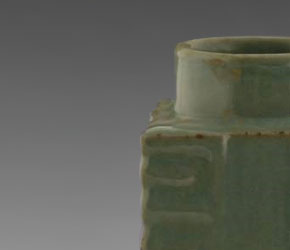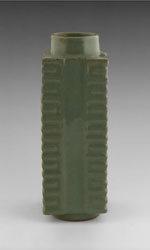| |
 |
| |
Chinese cong-form vase (detail) |
Since
Neolithic
times, the
Chinese
have been master carvers of jade and other hard stone ritual and decorative objects. Various forms of
hardstone
artifacts have been dated to as early as 5000 BC, and they performed a ritual function in aristocratic burials as late as the
Han dynasty
(206BC to 222 AD). The actual meaning of these objects is not clearly known, but they were likely intended to help the soul of the deceased on its journey to heaven. Consequently, the enormous labor involved in perfecting their abstract shapes and lustrous finish is striking testimony to these symbols of wealth and prestige, and their more recent production represents the continuity of Chinese culture through the repetition and imitation of revered classical forms.
 |
|
| Chinese cong-form vase |
|
Cong
– the impressive, yet enigmatic “cong” is a box-enclosed cylinder form with squared cross-section and a wide circular hole or opening. The cong was also introduced by the
Liangzhu
culture and is usually ornamented by carved or incised faces on its opposed corners. The form exists both as a short, almost bracelet shape and also in tall, tubular towers of 12” or more in height, which were delineated by uniform “stacking” registers. Workmanship and styles vary, with both delicate thin-walled examples and monolithic thick-walled pieces with a relatively small bore.
Download this Article: Archaic Chinese Cong Form Vase.pdf



